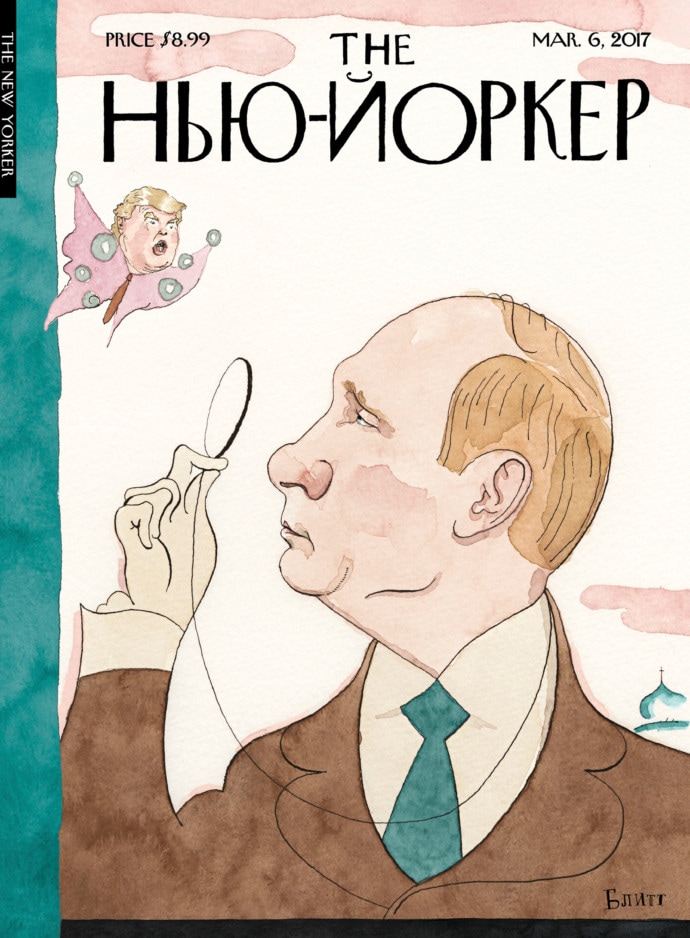|
The New Yorker has long been a literary icon but through the odd couple of David Remnick and Donald Trump it has even ratcheted up its importance as a worldwide asset.
Hardly an issue arrives without at least one article about the tentacles of money and power between the United States and Russia and beyond. In the March 6 issue is “Active Measures,” by Evan Osnos, Remnick and Joshua Yaffa, exploring just what Vladimir Putin is up to. At the core is Remnick’s own expertise from his long posting in Moscow. (He started as a young sportswriter, great company at the Olympics.) The March 6 cover is the annual homage to the New Yorker’s dandified mascot, Eustace Tilley, monocle and all, inspecting a yappy butterfly with orange hair. Putin’s normal expressionless face seems to show a trace of amusement: “Who is this strange little fellow?” The March 13 issue has an article by Adam Davidson entitled, “Donald Trump’s Worst Deal,” which could be almost anywhere. In this case it is about Trump sending his entrepreneurial daughter Ivanka-the-Brand to supervise a “luxury” (well, what isn’t?) hotel going up in a grubby corner of Baku, the capital of Azerbaijan. This Trumpian deal staggers like Trump’s desperate lunges for success in Russia but in this case some investors are from Iran. The Trump involvement is said to have been terminated in December -- after American voters chose this great American businessman as their president: its obligations and secrets glow like Chernobyl. Literature has not been ignored by the New Yorker. In the past two weeks there have been two magnificent pieces: In the March 6 issue is a short story by Zadie Smith (“Crazy They Call Me,” from the song) imagining the inner voice of Billie Holiday in her final days: every word, every detail, is exquisitely placed, phrase by phrase, leading to the final cry from the soul the reader knew was coming. In the March 13 issue is a poem by Robert Pinsky titled “Branca” -- an ode to the pitcher Ralph Branca who passed recently at 85. Mixing his pitches, the poet refers to Branca’s Calabrian name, his huge family of origin, his instant friendship with Jackie Robinson, and his victimization by enemy spying in the signature moment of his long and admirable life. The New Yorker is best held in the hand, read at leisure as a ritual, early in the work week. In this age, great journalism is being done by the Times and Washington Post on the split second, on the web, and the New Yorker has kept pace. As of Thursday morning I recommend the great Jelani Cobb’s dissection of the latest blathering by Dr. Ben Carson, who equated slavery with immigration. (I have often thought that Carson’s problems with language and reality stem from an infusion of too much anesthesia during the pediatric brain surgery he apparently performed for decades, masterfully. Or, is he doing a Pee-wee Herman imitation?) Cobb, as one would expect, goes beyond my flippancy. The New Yorker also features Roger Angell on the traditions of the magazine, and also occasional pieces on, thank goodness, baseball. * * * I hope these links can be accessed; a subscription to the New Yorker includes full access to the web site. Remnick et al: http://www.newyorker.com/magazine/2017/03/06/trump-putin-and-the-new-cold-war Davidson: http://www.newyorker.com/magazine/2017/03/13/donald-trumps-worst-deal Smith: http://www.newyorker.com/magazine/2017/03/06/crazy-they-call-me Pinsky: http://www.newyorker.com/magazine/2017/03/13/branca Cobb: http://www.newyorker.com/news/daily-comment/ben-carson-donald-trump-and-the-misuse-of-american-history?intcid=mod-latest Angell: http://www.newyorker.com/culture/culture-desk/looking-at-the-field
Joshua Rubin
3/9/2017 12:58:33 pm
Agree with everything you said. They play with the original Eustace B. Tilley cover every year on the mag's birthday, but this was the most playful and satirical yet.
George Vecsey
3/10/2017 11:02:21 am
Josh: Good priorities. Worry about the Vandals temporarily sacking the government (us) but also worrying about D'Arnaud's swing. Your message accompanied a message from an anonymous fan yesterday: Comments are closed.
|
Categories
All
|










